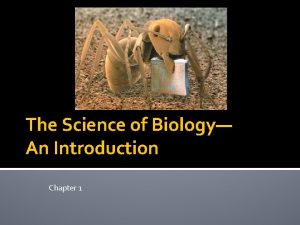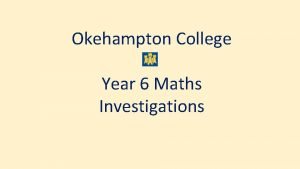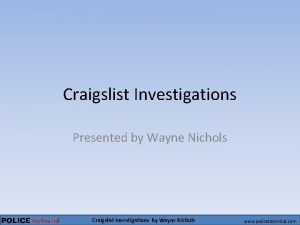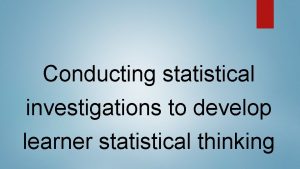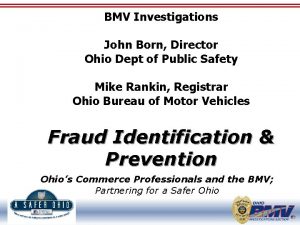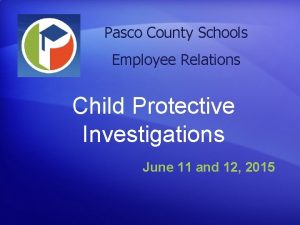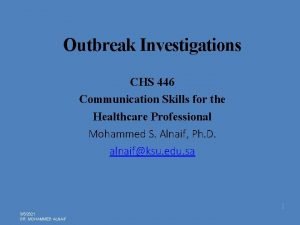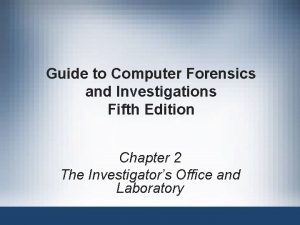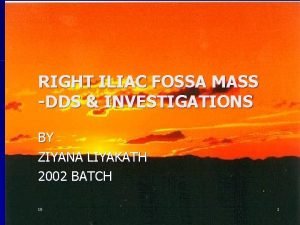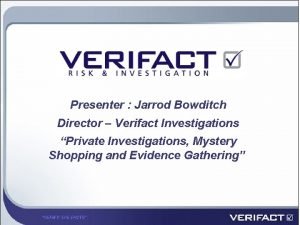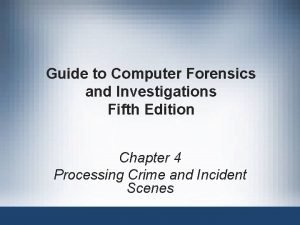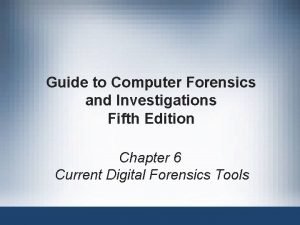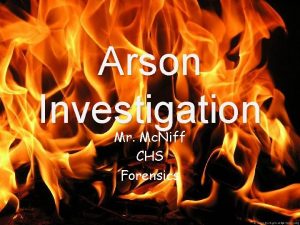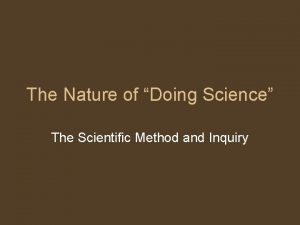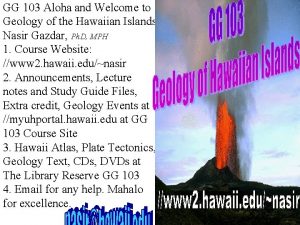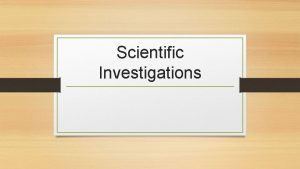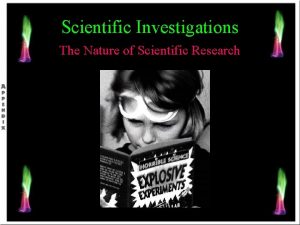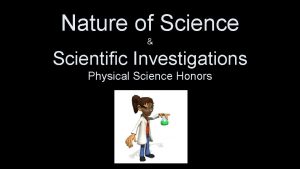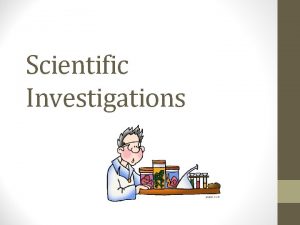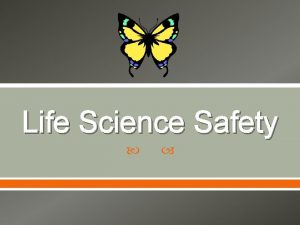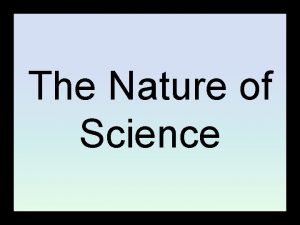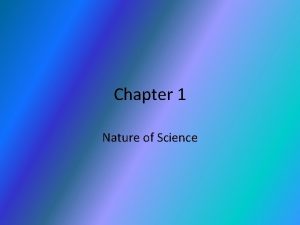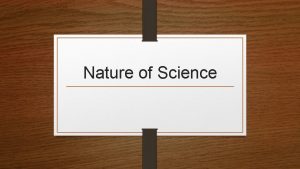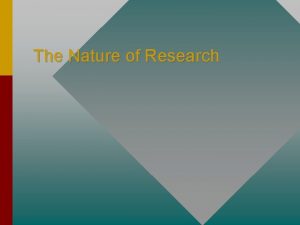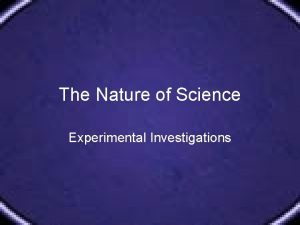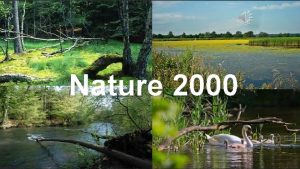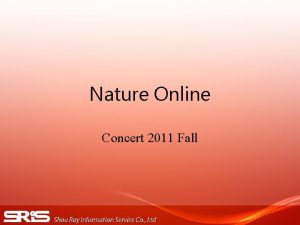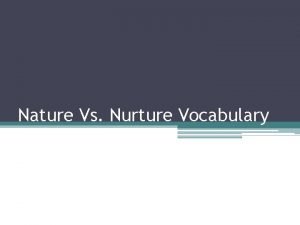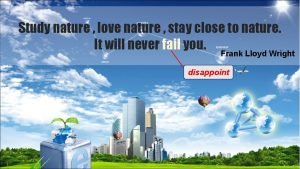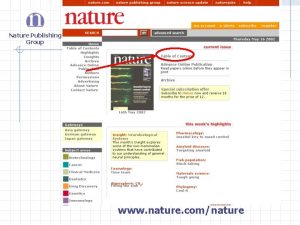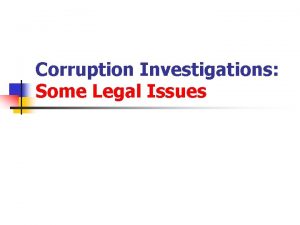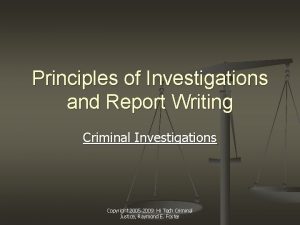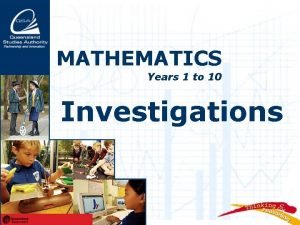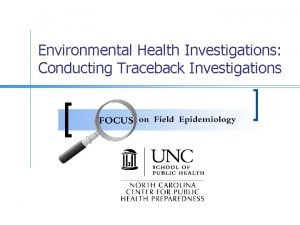Scientific Investigations The Nature of Scientific Research Science





























- Slides: 29

Scientific Investigations The Nature of Scientific Research

Science Builds on Good Observations • May be done by observing and reflecting on what other scientists have done • May be done by one’s own careful and thoughtful observations (seeing what others do not see) • May be done by making inferences on what you observe. Can you think like a scientist? Test your own powers of observation next →

Look at these five trees closely. How many testable hypotheses can you generate?

Hints to Find Three Hypotheses: • Think about the different sizes of the trees • Think about the number of trunks each tree has • Think about how the two smaller trees differ from each other • Think about the bushes growing under the trees • Go to next slide and look at picture again. Write at least 3 hypotheses to share with class.


Students can create multiple hypotheses from this picture. Have them work in groups to come up with some, check for accuracy and testability.

Good Research is Hypothesis-Driven. What does this mean? Why is it true?

So What is a Good Hypothesis? A possible explanation for an observation or a scientific problem. . . • Based on observations, inferences and previous knowledge. • Must be written as a statement. • Is a predictable or logical conclusion/result. • Is testable. • Found to be right or wrong at end of investigation.

Science is a Cyclic Process: Observe and Ask Questions Hypothesize Evaluate Data Design Test of Hypothesis Observe Conduct Experiment

Hypothesis Example • Fact: we know that plants need water. • Hypothesis: The plant will grow faster if the watering frequency is increased. • Test: Set up a test with 2 of the same kind of plant in the same pots and in same place of room. Give one plant a normal amount of water (record amount) necessary for growth and give one plant an increased amount (you must record how much you increase it by) observe over a period of time and record results. • You must have a control group and only one variable tested at a time!!

Go to the Links Below to Test your Hypothesis Ability!!! • http: //www. utas. edu. au/sciencelinks/exdesign/flash/ slotmach. swf • http: //www. utas. edu. au/sciencelinks/exdesign/flash/ hypoth. swf

3 Kinds of Hypotheses: • Manipulated Hypothesis - – A statement written when a variable is being manipulated to effect the result: – The plant will grow faster IF copper is added to soil. • Comparative Hypothesis – Used when investigating the preferences of an organism: – Dogs prefer wet food over dry food. • Descriptive Hypothesis – Used when observing organisms in their natural environment and conditions can not be changed or manipulated: – More moss grows on the side of rocks in shady wet areas than on the side of rocks in sunny dry areas.

How to Design an Experiment How do we test and control what happens in our experiments so the results can be trusted? • Experiment must test the hypothesis. • Account for all known variables. • Have a control group. • Make sure you have the tools needed to perform the experiment.

Testing Hypotheses Account for the “Variables” • Variables are factors or conditions that can vary and thus influence the results. • Only one variable should be tested at a time. • 3 Kinds of variables: – Independent variable = what you change or manipulate – Dependent variable = changes because of independent variable changing – Control variables = no changes at all, these must all be kept the same in experiment

Testing Hypotheses Continued • In addition to your variables, you must also have a Control Group. – A control group is an additional experiment run where no changes will be made to any of the variables. – This gives the scientist the ability to compare the results gathered from the tested group or item against a “normal” group. – This is how scientists determine if their independent variable is causing any effects on their experiment.

Example for Control Group From Plant With Copper Added to Soil Hypothesis: • The Control Group will be another of the same plants with all the same variables as tested plant, EXCEPT, it will have NO COPPER added to its soil at all. It will serve as the “normal” situation. The tester will compare his/her results from the tested plant to the plant that is “normal”. Example: Plant with no copper added Control Group Plant with copper added Test Group

Graphing Results: Students can easily plot their results on to a graph!

Experiment Let’s find out what happens when we conduct the tests!!

A General Rule in Science Experiments should be repeated, and similar results should occur each time for the results to be found as valid. Wright brothers Wilbur (R) and Orville (at controls) with their 1903 airplane “Kitty Hawk” on first flight lasting twelve seconds. Location: Kitty Hawk, NC, US Date taken: December 17, 1903

Results Could be Falsely Negative or Positive “Alternative Explanations” • Possible causes for misleading results/alternative explanations: 1. Test subject may be insensitive or too sensitive to the variable you expose it to. 2. Way of exposing variable to test subject may not be appropriate. 3. Dose may not be adequate. 4. Time of exposure may be too short or too long. 5. Too few test subjects could produce results that are not representative of a larger group.

Analyze the Results • Describe what happened in the experiment. • Display results using graphs, tables, map, and charts. • Perform any calculations necessary to clarify the data.

Common Interpretation Errors • Assuming that if two events occur together, one must be causing the other. • Failure to consider alternative explanations. • Extending conclusions beyond what is supported by the data.

Science is a Way of Knowing The process of research can involve several steps. These levels are summarized below. • OBSERVATION: What is happening? • QUESTION: What would happen if. . . ? • HYPOTHESIS: ____ should happen if. . . … • ALTERNATIVE HYPOTHESES: _____or _________ should happen if. . … • EXPERIMENT: Collect the data. • RESULTS: What actually happened? • CONCLUSION: The hypothesis was correct/incorrect because. . .

Questions Can be Asked About Any Thing! This is Scientific Inquiry! Look at this picture and develop a hypothesis that is being tested.

In Science, Decisions are Based on Evidence!

Consequences of Scientific Evidence • EVIDENCE-BASED DECISIONS: What do we want to make happen as a result of the evidence? • VALUES: What happenings do we want to preserve and extend? • FUTURE DIRECTIONS: What do we want to make happen next? Where will these results lead us in the future?

Theories in Science • Theories can be more important than isolated facts. • Theories guide the direction of research, providing the context in which ideas and hypotheses are generated. • Good theories show many isolated facts are compatible and consistent with each other. • Good theories stand the test of time, but may be replaced when a better theory comes along.

Everybody Can Think Like a Scientist • • • Observe. Listen. Read. Ask questions. What is the evidence? Do I have access to all the evidence? Is the evidence good? Ø Ø Ø How much evidence is there? Is evidence based on fact or opinion? Does evidence come from several INDEPENDENT sources? • How can I test to see if the evidence is correct?

Interesting Websites: • http: //boyslife. org/hobbies-projects/funstuff/2184/weirdscience/comment-page-5/ • http: //sciencecastle. com/sc/index. php/rooms/view/6 • http: //www. tnmanning. com/Tests/scientific_inquiry_p rocess. htm • http: //nces. ed. gov/nceskids/createagraph/default. aspx? ID= 3 f 359 c 1 f 0 dae 49 e 0 b 31 f 3 ba 396 f 73 cb 2 Make science fun and safe!!
 Observation in scientific method
Observation in scientific method Forensic science fundamentals and investigations chapter 6
Forensic science fundamentals and investigations chapter 6 Practical research 2 nature of inquiry and research
Practical research 2 nature of inquiry and research Maths is my favourite subject
Maths is my favourite subject Why aren t descriptive investigations repeatable
Why aren t descriptive investigations repeatable Nrich maths investigations
Nrich maths investigations Craigslist wayne
Craigslist wayne Guide to computer forensics and investigations
Guide to computer forensics and investigations Unit 3 statistical studies answers
Unit 3 statistical studies answers Types of statistical investigation
Types of statistical investigation Toledo bmv heatherdowns
Toledo bmv heatherdowns Pasco child protective services
Pasco child protective services Chs investigations
Chs investigations Guide to computer forensics and investigations 5th edition
Guide to computer forensics and investigations 5th edition Iliac region
Iliac region Jarrod bowditch
Jarrod bowditch Antenatal investigations
Antenatal investigations Investigations
Investigations Guide to computer forensics and investigations
Guide to computer forensics and investigations Chs investigations
Chs investigations Nature and nature's laws lay hid in night
Nature and nature's laws lay hid in night Nature nature controversy
Nature nature controversy Nature of scientific inquiry
Nature of scientific inquiry What does gg mean
What does gg mean Hát kết hợp bộ gõ cơ thể
Hát kết hợp bộ gõ cơ thể Slidetodoc
Slidetodoc Bổ thể
Bổ thể Tỉ lệ cơ thể trẻ em
Tỉ lệ cơ thể trẻ em Chó sói
Chó sói Chụp phim tư thế worms-breton
Chụp phim tư thế worms-breton




